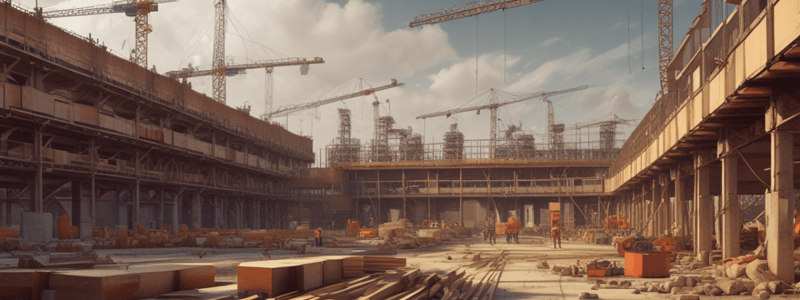Podcast
Questions and Answers
What is one of the purposes of specifications mentioned in the text?
What is one of the purposes of specifications mentioned in the text?
- Assisting in risk management
- Facilitating project coordination
- Ensuring regulatory compliance (correct)
- Enhancing communication among team members
How do specifications aid in project cost calculation?
How do specifications aid in project cost calculation?
- By promoting project coordination
- By managing project risks
- By facilitating procurement
- By outlining required materials and quantities (correct)
Why are specifications important for risk management according to the text?
Why are specifications important for risk management according to the text?
- To facilitate project coordination
- To identify potential risks early in the project (correct)
- To enhance communication among team members
- To comply with relevant codes and regulations
How do specifications contribute to project coordination?
How do specifications contribute to project coordination?
In what aspect of the project do specifications help obtain accurate and competitive bids?
In what aspect of the project do specifications help obtain accurate and competitive bids?
What role do specifications play in obtaining permits from regulatory authorities?
What role do specifications play in obtaining permits from regulatory authorities?
What does construction economics primarily involve?
What does construction economics primarily involve?
Which component is NOT a key component of construction economics?
Which component is NOT a key component of construction economics?
What type of estimation involves a competitive estimate submitted by a contractor?
What type of estimation involves a competitive estimate submitted by a contractor?
Which factor influences construction economics related to the availability and prices of construction materials?
Which factor influences construction economics related to the availability and prices of construction materials?
What aspect of estimations involves an in-depth analysis of costs based on detailed project plans and specifications?
What aspect of estimations involves an in-depth analysis of costs based on detailed project plans and specifications?
Which element is NOT considered a key component of construction economics?
Which element is NOT considered a key component of construction economics?
What is the purpose of quantity takeoff in construction estimations?
What is the purpose of quantity takeoff in construction estimations?
Which factor is considered in resource allocation in construction economics?
Which factor is considered in resource allocation in construction economics?
How does construction economics address risk management?
How does construction economics address risk management?
What concept does construction economics consider when evaluating financial assessments?
What concept does construction economics consider when evaluating financial assessments?
What is the primary focus of cost management in construction economics?
What is the primary focus of cost management in construction economics?
Which aspect does life cycle costing examine in construction projects?
Which aspect does life cycle costing examine in construction projects?
In construction estimations, what does overhead and profit include?
In construction estimations, what does overhead and profit include?
What is the main purpose of value engineering in construction?
What is the main purpose of value engineering in construction?
What is one factor that can impact project costs due to supply and demand dynamics?
What is one factor that can impact project costs due to supply and demand dynamics?
Why is it essential to understand the time value of money in construction economics?
Why is it essential to understand the time value of money in construction economics?
What role does the project manager play in a construction project?
What role does the project manager play in a construction project?
Why is compliance with building codes important in construction projects?
Why is compliance with building codes important in construction projects?
Which stakeholder determines project objectives and has the final say in major decisions?
Which stakeholder determines project objectives and has the final say in major decisions?
What is the main responsibility of engineers in a construction project?
What is the main responsibility of engineers in a construction project?
Why is estimation considered a crucial process in the construction industry?
Why is estimation considered a crucial process in the construction industry?
What is the primary purpose of conducting a feasibility study in construction projects?
What is the primary purpose of conducting a feasibility study in construction projects?
In competitive bidding scenarios, what do contractors rely on accurate estimates for?
In competitive bidding scenarios, what do contractors rely on accurate estimates for?
Who are external experts hired to provide specialized advice in a construction project?
Who are external experts hired to provide specialized advice in a construction project?
What is the role of financial institutions in a construction project?
What is the role of financial institutions in a construction project?
How does sustainability impact construction economics?
How does sustainability impact construction economics?
Which estimation method involves estimating costs based on the area or volume of the building?
Which estimation method involves estimating costs based on the area or volume of the building?
What is the advantage of Detailed Estimation over Approximate Estimation?
What is the advantage of Detailed Estimation over Approximate Estimation?
Which method combines elements of both approximate and detailed estimation?
Which method combines elements of both approximate and detailed estimation?
What factor influences the choice between approximate and detailed estimation methods?
What factor influences the choice between approximate and detailed estimation methods?
In construction, which method involves assigning a unit cost to various elements based on historical data?
In construction, which method involves assigning a unit cost to various elements based on historical data?
Which method is suitable for more complex structures in construction projects?
Which method is suitable for more complex structures in construction projects?
What is the primary advantage of Approximate Estimation over Detailed Estimation?
What is the primary advantage of Approximate Estimation over Detailed Estimation?
Which method involves estimating based on functional units like classrooms or hospital beds?
Which method involves estimating based on functional units like classrooms or hospital beds?
What is the main purpose of providing contingency allowances in estimations for a project?
What is the main purpose of providing contingency allowances in estimations for a project?
What role does accurate estimation play in client communication?
What role does accurate estimation play in client communication?
Why are estimations important for financial control in a project?
Why are estimations important for financial control in a project?
What is the unit of measurement for weight as per IS1200 IS Code?
What is the unit of measurement for weight as per IS1200 IS Code?
How does estimation contribute to project scheduling?
How does estimation contribute to project scheduling?
What is the purpose of measuring the thickness of an RCC slab to the nearest 0.005m?
What is the purpose of measuring the thickness of an RCC slab to the nearest 0.005m?
In what unit is volume measured as per IS1200 IS Code?
In what unit is volume measured as per IS1200 IS Code?
What is the significance of measuring the length of steel reinforcement bar to the nearest 0.005m?
What is the significance of measuring the length of steel reinforcement bar to the nearest 0.005m?
Why are unit measurements crucial in resource planning?
Why are unit measurements crucial in resource planning?
How does accurate estimation assist in effective resource planning?
How does accurate estimation assist in effective resource planning?
Flashcards are hidden until you start studying
Study Notes
Construction Economics and Estimations
- Definition: Construction economics is the study of the economic aspects and principles related to construction projects.
- Key Components:
- Cost Analysis: Evaluating costs associated with construction, including materials, labor, equipment, and overhead.
- Supply and Demand: Understanding market forces affecting the availability and cost of construction resources.
- Project Financing: Managing the financial aspects of construction projects, including funding, loans, and returns on investment.
Estimations in Construction
- Definition: Estimation in construction refers to the process of predicting the costs, time, and resources required for a construction project.
- Types of Estimations:
- Preliminary Estimate: Rough cost estimation done in the early stages of project planning.
- Detailed Estimate: In-depth analysis of costs based on detailed project plans and specifications.
- Bid Estimate: A competitive estimate submitted by a contractor in response to a project's bid.
Factors Influencing Construction Economics and Estimations
- Materials: Prices and availability of construction materials.
- Labor: Costs associated with hiring and managing skilled and unskilled labor.
- Location: Geographic factors affecting logistics and costs.
- Market Conditions: Economic trends, inflation, and local market conditions affecting costs.
- Project Scope: The size, complexity, and nature of the project.
Key Processes in Estimations
- Quantity Takeoff: Determining the quantities of materials needed for the project based on drawings and specifications.
- Unit Cost Estimation: Assigning costs to each unit of work or material.
- Overhead and Profit: Adding overhead costs (indirect expenses) and profit margin to the direct costs.
- Contingency: Including a contingency allowance for unforeseen circumstances or changes.
Software and Tools in Estimations
- Estimation Software: Utilizing specialized software like ProEst, Sage Estimating, or BuildingConnected for accurate and efficient estimations.
- Building Information Modeling (BIM): Integrating BIM technology for 3D modeling and collaborative project planning.
Challenges in Construction Economics and Estimations
- Uncertainties: Changes in market conditions, project scope, or unexpected events.
- Inaccurate Information: Insufficient or inaccurate data in project plans and specifications.
- Regulatory Changes: Changes in regulations impacting construction practices.
Continuous Monitoring and Adaptation
- Cost Control: Regularly monitoring project costs and adjusting the budget as needed.
- Value Engineering: Finding ways to optimize costs without compromising project quality.
Documentation
- Detailed Records: Maintaining accurate records of costs, changes, and unforeseen events for future reference.
Stakeholders in Construction Projects
- Owner/Client: The individual or organization that initiates and funds the construction project.
- Project Manager: Responsible for overall project planning, execution, and completion.
- Contractor: The entity responsible for executing the construction work.
- Architect/Designer: Designs the project, develops plans, and ensures that the construction meets specified standards and regulations.
- Engineers: Civil, structural, mechanical, and electrical engineers play crucial roles in the planning, design, and implementation of various aspects of the construction project.
- Consultants: External experts hired to provide specialized advice.
- Government Authorities/Regulatory Bodies: Agencies responsible for enforcing building codes, zoning regulations, and other legal requirements.
- Financial Institutions: Provide funding and financial support for the construction project.
- End Users/Occupants: Individuals or organizations for whom the construction project is being undertaken.
Need for Estimation
- Budgeting: Cost Planning: Estimation helps in forecasting costs associated with a construction project.
- Project Feasibility: Financial Viability: Estimation is integral to conducting a feasibility study, helping stakeholders assess whether the benefits of the project justify the costs.
- Decision-Making: Informed Decision-Making: Accurate estimations provide stakeholders with the information needed to make informed decisions about the project.
- Competitive Bidding: Bid Preparation: In competitive bidding scenarios, contractors rely on accurate estimates to prepare competitive bids.
- Resource Planning: Materials, Labor, and Equipment: Estimations help in determining the quantities of materials, labor, and equipment needed for a project.
- Project Scheduling: Time Estimation: Estimations contribute to the development of project schedules by providing insights into the time required for each activity.
- Risk Management: Identification of Contingencies: Estimations include contingency allowances for unforeseen events or changes in project scope.
- Client Communication: Transparency: Accurate estimates enhance transparency in communication with clients.
- Financial Control: Cost Control: Estimations act as a baseline for cost control throughout the project.
Units of Measurement
- Dimension: Measured to the nearest 0.01 m.
- Area: Worked out to the nearest 0.01 sq.m.
- Cubic content: Calculated to the nearest 0.01 cu.m.
- Weight: Worked out to the nearest 0.001 tonnes.
- Thickness of RCC slab: Measured to the nearest 0.005 m.
- Thickness of woodwork: Measured to the nearest 0.002m.
- Thickness of steelwork: Measured to the nearest 0.001m.
- Length of steel reinforcement bar: Measured to the nearest 0.005 m and its diameter to the nearest 0.0001 m.
- Area of steel: Measured to the nearest 0.0001 cu.m.
- Volume: Measured to the nearest 0.01 cu.m., but the volume of wood shall be measured to the nearest 0.001 cu.m.
Methods of Measurement
- Earthwork in excavation: Measured in cu.m.
- Surfacing and dressing: Measured in sq.m.
- Filling in plinth and foundation: Measured in cu.m.
- Exaction for pipe, cable, etc.: Measured in m.
- Brickwork: Measured in cu.m.
- Brickbat cement concrete: Measured in cu.m.
- P.C.C.: Measured in cu.m.
- R.C.C.: Measured in cu.m.
- Damp proof course: Measured in sq.m.
- Reinforcement steel: Measured in kg.
- Centering and shuttering: Measured in sq.m.
Studying That Suits You
Use AI to generate personalized quizzes and flashcards to suit your learning preferences.





